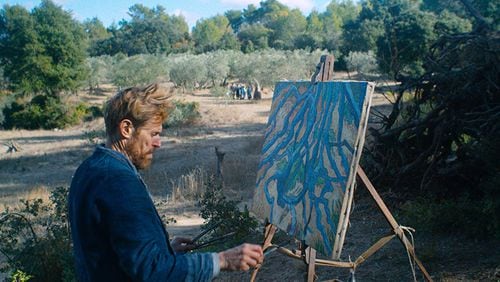A broken visionary endures a harsh, nearly penniless life, for a while, while making the world a richer place one unfashionable canvas at a time.
With a story like that, it’s no wonder any new film about Vincent van Gogh tends to put moviegoers in a defensive crouch. Yet an improbable number of filmmakers of very different temperaments have successfully envisioned the Dutch Post-Impressionist’s acts of tormented creation on screen.
Julian Schnabel provides the latest and one of the best with “At Eternity’s Gate,” a fierce, immediate and often inspired response to van Gogh’s life and work.
This is the fifth narrative feature from the painter and filmmaker, focused on the final two years of what van Gogh’s life near the end might’ve been like. Not everything in Schnabel’s film works. But it’s both serious and cinematically vital, with Willem Dafoe’s persuasive, movingly enacted van Gogh doing a great deal of the heavy lifting from the neck up, with his haunted eyes alone.
The title of the screenplay, written by Schnabel, Louise Kugelberg and Jean-Claude Carrière, refers to the painting “Sorrowing Old Man (At Eternity’s Gate),” produced two months before van Gogh’s probable suicide. Schnabel and others dispute that suicide, and posit different circumstances for the painter’s death in 1890 at the age of 37. Dafoe, now 63, may be a generation older than the real van Gogh, but it doesn’t matter. He’s the right, fervent actor for the role, and age in this case becomes irrelevant.
Much of the voiceover narration and dialogue adapts van Gogh’s letters to his patron brother, Theo (Rupert Friend), who championed van Gogh when few others saw the beauty in his hallucinations. “At Eternity’s Gate” begins with a three-word sentence: “Look at me.” Van Gogh spies a shepherdess on the road, and must paint her. He approaches the woman, who regards him (us, that is; the camera takes von Gogh’s point of view) with fear. We return to this moment and those three words later in director Schnabel’s film, so that the portrait of van Gogh becomes an anguished plea for us to recognize one man’s otherworldly talent.
Schnabel’s cinematographer Benoit Delhomme shoots much of “At Eternity’s Gate” at a literal trot, running with the camera, creating a hurtling feeling of momentum. It’s probably too much, too self-consciously dizzying in effect. Sporadically Schnabel’s photographically utilizes what’s known as a “split diopter” creating a bifocal effect, blurred in one half, clear in the other, mustard-yellow overall. (Call it “VincentVision.”)
Schnabel’s earlier films about art, artists and risk include “Basquiat” (1996), about the New York street artist, and “Before Night Falls” (2000), on Cuban poet and novelist Reinaldo Arenas. His masterwork, for me, remains “The Diving Bell and the Butterfly” (2007), a brilliantly realized account of how French Elle editor Jean-Dominique Bauby managed to “blink” out a memoir, Morse code style, with his left eye, after a near-fatal car crash left him in near-total paralysis. “At Eternity’s Gate” is a smaller, less flamboyant achievement, but it’s quite something. It sees van Gogh the way he might’ve seen the world around him, threatening and supple. Dafoe never begs for attention or sympathy; he’s there, like the seasoned, craftsmanlike actor he is, as a conduit and a sort of medium.
MOVIE REVIEW
“At Eternity’s Gate”
Grade: B+
Starring Willem Dafoe, Mads Mikkelson and Amira Casar. Directed by Julian Schnabel.
Rated PG-13 for some thematic content. Check listings for theaters. 1 hour, 51 minutes.
Bottom line: Film that sees van Gogh the way he might've seen the world around him
About the Author






